Developing an Automated Analytical Process for Disaster Response and Recovery in Communities Prone to Isolation
Abstract
1. Introduction
1.1. Background
- (1)
- What are the essential geospatial technologies that can be used to help people living in communities that are vulnerable in the event of a disaster?
- (2)
- Why do we need an analytical process to identify and analyze isolated communities in real disaster situations, and what analytical procedures are required for the communities that are prone to isolation?
- (3)
- What kind of systems can disaster managers use to deliver information relevant in isolated areas to citizens in real time, and how can they efficiently operate them?
- (4)
- Can we develop scenario-based approaches on web maps to rapidly help isolated communities at risk of disasters?
1.2. Previous Studies
2. Materials and Methods
2.1. Materials
2.1.1. Study Area
2.1.2. Data Collection
2.2. Methods
2.2.1. Schematic Diagram for this Study
2.2.2. Development of the Three Modules
- First module: Extracting isolated communities affected by disaster
- B.
- Second module: Analytical procedures for disaster response
- C.
- Third module: Developing a web-enabled GIS application
3. Results
3.1. Real Application with Three Communities where Disasters Have Occurred in the Past
3.2. Web-Enabled GIS Application
4. Discussion
5. Conclusions
Author Contributions
Funding
Conflicts of Interest
References
- Kim, J.M.; Kim, T.; Son, K.; Yum, S.G.; Ahn, S. Measuring vulnerability of typhoon in residential facilities: Focusing on typhoon Maemi in South Korea. Sustainability 2019, 11, 2768. [Google Scholar] [CrossRef]
- Emmer, A. Geographies and scientometrics of research on natural hazards. Geosciences 2018, 8, 382. [Google Scholar] [CrossRef]
- Moon, I.J.; Oh, I.S.; Murty, T.; Youn, Y.H. Causes of the unusual coastal flooding generated by Typhoon Winnie on the west coast of Korea. Nat. Hazards 2003, 29, 485–500. [Google Scholar] [CrossRef]
- Deng, L.; Wang, W.; Yu, Y. State-of-the-art review on the causes and mechanisms of bridge collapse. J. Perform. Constr. Facil. 2016, 30, 04015005. [Google Scholar] [CrossRef]
- Wang, W.C.; Hsieh, M.C.; Huang, C.H. Applying Prim’s algorithm to identify isolated areas for natural disaster prevention and protection. Engineering 2018, 10, 417. [Google Scholar] [CrossRef][Green Version]
- Jung, K.; Song, M.; Feiock, R. Isolated and broken bridges from interorganizational emergency management networks: An institutional collective action perspective. Urban Aff. Rev. 2019, 55, 950–975. [Google Scholar] [CrossRef]
- Wood, N.; Jones, J.; Schmidtlein, M.; Schelling, J.; Frazier, T. Pedestrian flow-path modeling to support tsunami evacuation and disaster relief planning in the US Pacific Northwest. Int. J. Disaster Risk Reduct. 2016, 18, 41–55. [Google Scholar] [CrossRef]
- Poser, K.; Dransch, D. Volunteered geographic information for disaster management with application to rapid flood damage estimation. Geomatica 2010, 64, 89–98. [Google Scholar]
- Lulla, K.; Nellis, M.D.; Rundquist, B. Celebrating 40 years of Landsat program’s Earth observation accomplishments. Geocarto Int. 2012, 27, 459. [Google Scholar] [CrossRef]
- Jedlovec, G. Advances in Geoscience and Remote Sensing, 1st ed.; IntechOpen: London, UK, 2009; pp. 317–344. [Google Scholar]
- Tomaszewski, B. Geographic Information Systems (GIS) for Disaster Management, 2nd ed.; Routledge: New York, NY, USA, 2021; pp. 1–52. [Google Scholar]
- Choi, J.; Cooke, W.H.; Stevens, M.D. Development of a water budget management system for fire potential mapping. GIScience Remote Sens. 2009, 46, 39–53. [Google Scholar] [CrossRef]
- Joyce, K.E.; Wright, K.C.; Samsonov, S.V.; Ambrosia, V.G. Remote sensing and the disaster management cycle. Adv. Geosci. Remote Sens. 2009, 48, 317–346. [Google Scholar]
- Yang, B. GIS based 3-D landscape visualization for promoting citizen’s awareness of coastal hazard scenarios in flood prone tourism towns. Appl. Geogr. 2016, 76, 85–97. [Google Scholar] [CrossRef]
- De Guttry, C.; Ratter, B. Expiry date of a disaster: Memory anchoring and the storm surge 1962 in Hamburg, Germany. Int. J. Disaster Risk Reduct. 2022, 70, 102719. [Google Scholar] [CrossRef]
- Rehman, J.; Sohaib, O.; Asif, M.; Pradhan, B. Applying systems thinking to flood disaster management for a sustainable development. Int. J. Disaster Risk Reduct. 2019, 36, 101101. [Google Scholar] [CrossRef]
- Rashkovetsky, D.; Mauracher, F.; Langer, M.; Schmitt, M. Wildfire detection from multisensor satellite imagery using deep semantic segmentation. IEEE J. Sel. Top. Appl. Earth Obs. Remote Sens. 2021, 14, 7001–7016. [Google Scholar] [CrossRef]
- Govil, K.; Welch, M.L.; Ball, J.T.; Pennypacker, C.R. Preliminary results from a wildfire detection system using deep learning on remote camera images. Remote Sens. 2020, 12, 166. [Google Scholar] [CrossRef]
- Zhao, N.; Liu, Y.; Hsu, F.C.; Samson, E.L.; Letu, H.; Liang, D.; Cao, G. Time series analysis of VIIRS-DNB nighttime lights imagery for change detection in urban areas: A case study of devastation in Puerto Rico from hurricanes Irma and Maria. Appl. Geogr. 2020, 120, 102222. [Google Scholar] [CrossRef]
- De Alwis Pitts, D.A.; So, E. Enhanced change detection index for disaster response, recovery assessment and monitoring of accessibility and open spaces (camp sites). Int. J. Appl. Earth Obs. Geoinf. 2017, 57, 49–60. [Google Scholar] [CrossRef]
- Liu, T.; Yang, L.; Lunga, D. Change detection using deep learning approach with object-based image analysis. Remote Sens. Environ. 2021, 256, 112308. [Google Scholar] [CrossRef]
- Shirowzhan, S.; Sepasgozar, S.M.; Li, H.; Trinder, J.; Tang, P. Comparative analysis of machine learning and point-based algorithms for detecting 3D changes in buildings over time using bi-temporal lidar data. Autom. Constr. 2019, 105, 102841. [Google Scholar] [CrossRef]
- McSwain, N.E. Disaster response. Natural disaster: Katrina. Surg. Today 2010, 40, 587–591. [Google Scholar] [CrossRef]
- Kim, E.K. Innovative strategy to produce disaster map according to CDM life cycle in South Korea. Spat. Inf. Res. 2016, 24, 401–408. [Google Scholar] [CrossRef]
- Sakakibara, H.; Kajitani, Y.; Okada, N. Road network robustness for avoiding functional isolation in disasters. J. Transp. Eng. 2004, 130, 560–567. [Google Scholar] [CrossRef]
- Shin, Y.; Kim, S.; Moon, I. Integrated optimal scheduling of repair crew and relief vehicle after disaster. Comput. Oper. Res. 2019, 105, 237–247. [Google Scholar] [CrossRef]
- Sheng, N.; Jia, Y.; Xu, Z.; Ho, S.L.; Wai Kan, C. A complex network based model for detecting isolated communities in water distribution networks. Chaos Interdiscip. J. Nonlinear Sci. 2013, 23, 043102. [Google Scholar] [CrossRef] [PubMed]
- Capocci, A.; Servedio, V.D.; Caldarelli, G.; Colaiori, F. Detecting communities in large networks. Phys. A Stat. Mech. Its Appl. 2005, 352, 669–676. [Google Scholar] [CrossRef]
- Hwang, C.S.; Hong, S.Y.; Hwang, T.; Yang, B. Strengthening the statistical summaries of economic output areas for urban planning support systems. Sustainability 2020, 12, 5640. [Google Scholar] [CrossRef]
- Morning, A. Ethnic classification in global perspective: A cross-national survey of the 2000 census round. Soc. Stat. Ethn. Divers. 2015, 17–37. [Google Scholar]
- Baffour, B.; King, T.; Valente, P. The modern census: Evolution, examples and evaluation. Int. Stat. Rev. 2013, 81, 407–425. [Google Scholar] [CrossRef]
- Abdel-Aty, M.; Lee, J.; Siddiqui, C.; Choi, K. Geographical unit based analysis in the context of transportation safety planning. Transp. Res. Part A Policy Pract. 2013, 49, 62–75. [Google Scholar] [CrossRef]
- Qiu, F.; Sridharan, H.; Chun, Y. Spatial autoregressive model for population estimation at the census block level using LIDAR-derived building volume information. Cartogr. Geogr. Inf. Sci. 2010, 37, 239–257. [Google Scholar] [CrossRef]
- Lwin, K.; Murayama, Y. A GIS approach to estimation of building population for micro-spatial analysis. Trans. GIS 2009, 13, 401–414. [Google Scholar] [CrossRef]
- Mansourian, A.; Rajabifard, A.; Zoej, M.V.; Williamson, I. Using SDI and web-based system to facilitate disaster management. Comput. Geosci. 2006, 32, 303–315. [Google Scholar] [CrossRef]
- Olyazadeh, R.; Aye, Z.C.; Jaboyedoff, M.; Derron, M. Prototype of an open-source web-GIS platform for rapid disaster impact assessment. Spat. Inf. Res. 2016, 24, 203–210. [Google Scholar] [CrossRef]
- Haklay, M.; Weber, P. Openstreetmap: User-generated street maps. IEEE Pervasive Comput. 2008, 7, 12–18. [Google Scholar] [CrossRef]
- Goodchild, M.F. Citizens as sensors: The world of volunteered geogarphy. GeoJournal 2007, 69, 211–221. [Google Scholar] [CrossRef]
- Haworth, B.; Bruce, E. A review of volunteered geographic information for disaster management. Geogr. Compass 2015, 9, 237–250. [Google Scholar] [CrossRef]
- Kusumo, A.N.L.; Reckien, D.; Verplanke, J. Utilising volunteered geographic information to assess resident’s flood evacuation shelters. Case study: Jakarta. Appl. Geogr. 2017, 88, 174–185. [Google Scholar] [CrossRef]
- Gao, H.; Barbier, G.; Goolsby, R. Harnessing the crowdsourcing power of social media for disaster relief. IEEE Intell. Syst. 2011, 26, 10–14. [Google Scholar] [CrossRef]
- Pultar, E.; Raubal, M.; Cova, T.J.; Goodchild, M.F. Dynamic GIS case studies: Wildfire evacuation and volunteered geographic information. Trans. GIS 2009, 13, 85–104. [Google Scholar] [CrossRef]
- National Geographic Information Institute. Available online: http://map.ngii.go.kr/ms/map/NlipMap.do (accessed on 23 September 2022).
- Statistics, Korea. Available online: https://sgis.kostat.go.kr/contents/shortcut/shortcut_05.jsp (accessed on 23 September 2022).
- Ministry of the Interior and Safety. Available online: https://safekorea.go.kr/idsiSFK/neo/main_m/res/evacuateList.html (accessed on 23 September 2022).
- Estrada, E.; Rodriguez-Velazquez, J.A. Subgraph centrality in complex networks. Phys. Rev. E 2005, 71, 056103. [Google Scholar] [CrossRef] [PubMed]
- Liu, X.; Gong, D. A Comparative Study of Astar Algorithms for Search and Rescue in Perfect Maze. In Proceedings of the 2011 International Conference on Electric Information and Control Engineering, Wuhan, China, 15–17 April 2011. [Google Scholar]
- Ministry of Public Administration and Security. Available online: https://www.mois.go.kr/frt/bbs/type001/commonSelectBoardArticle.do?bbsId=BBSMSTR_000000000336&nttId=73398 (accessed on 14 March 2022).
- Korea Forest Service. 2021 Wildfire Report; Korea Forest Service: Daejeon, Korea, 2022; pp. 1–265. [Google Scholar]
- Hyndman, D.; Hyndman, D. Natural Hazards and Disasters, 5th ed.; Cengage Learning: Boston, MA, USA, 2016; pp. 1–14. [Google Scholar]
- UNDP, A. A Climate Risk Management Approach to Disaster Reduction and Adaptation to Climate Change. In Proceedings of the UNDP Expert Group Meeting: Integrating Disaster Reduction with Adaptation to Climate Change, Havana, Cuba, 19–21 June 2002. [Google Scholar]
- IPCC. Managing the Risks of Extreme Events and Disasters to Advance Climate Change Adaptation: Special Report of the Intergovernmental Panel on Climate Change; Cambridge University Press: New York, NY, USA, 2012; pp. 1–582. [Google Scholar]
- IPCC. Climate Change 2022: Impacts, Adaptation and Vulnerability; Cambridge University Press: New York, NY, USA, 2022; pp. 2411–2538. [Google Scholar]
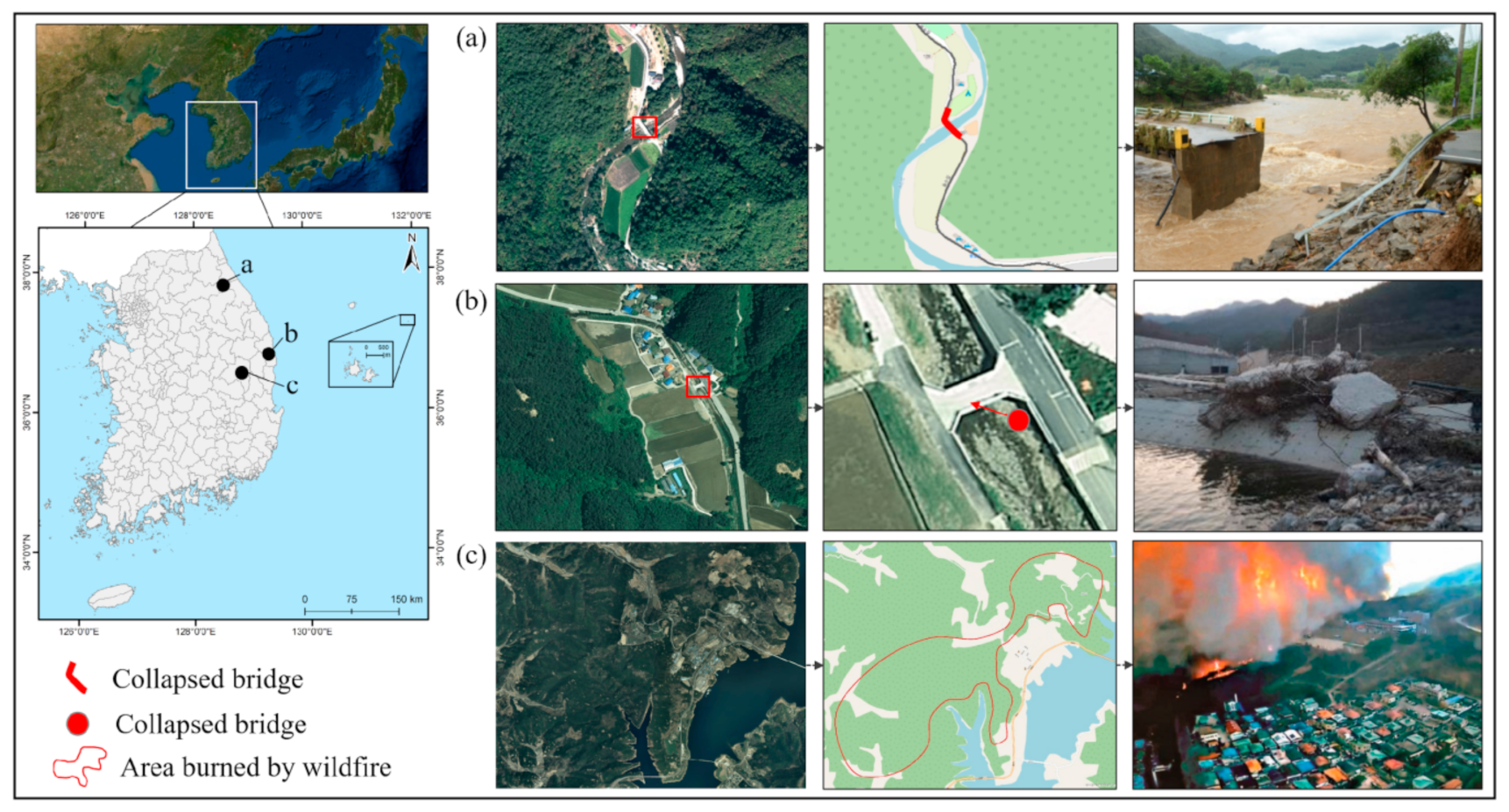
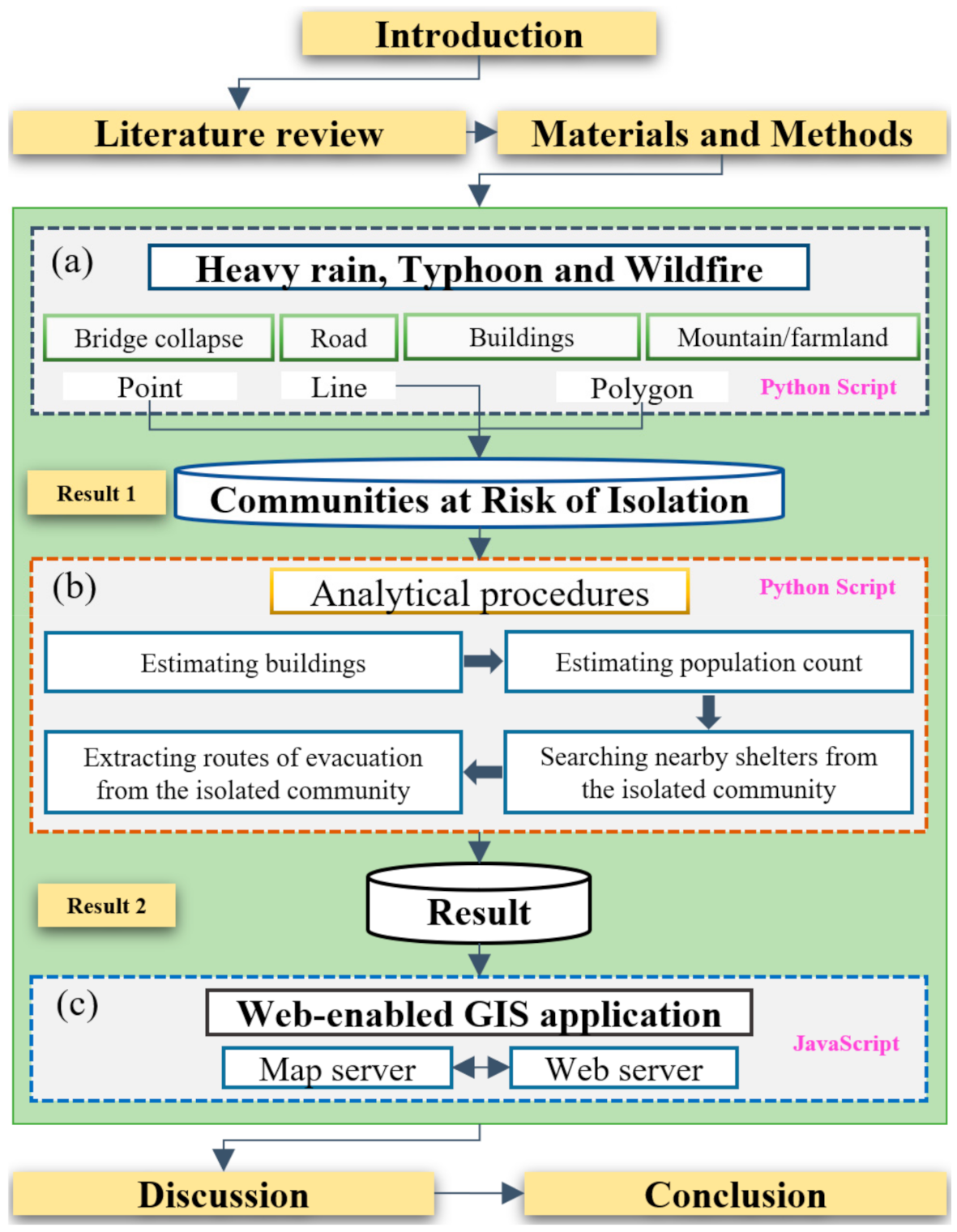
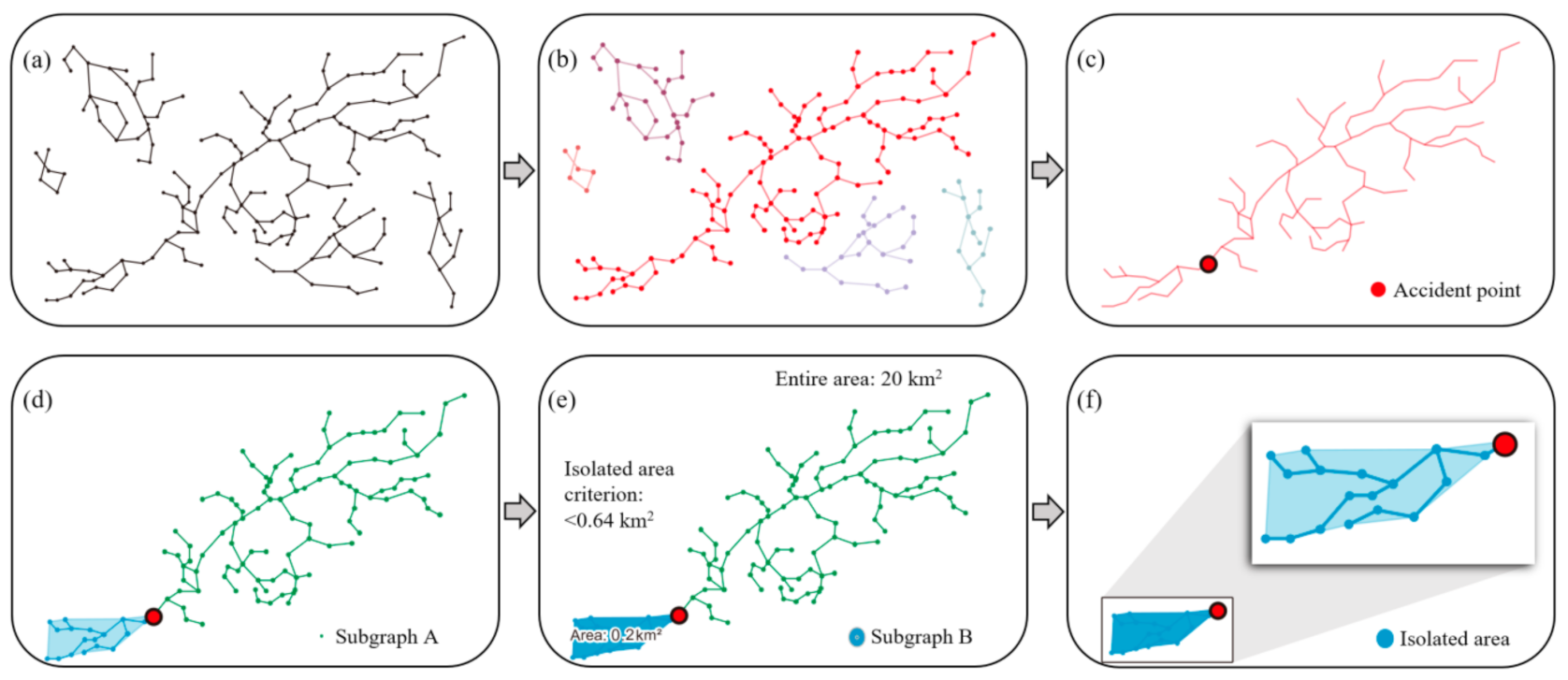
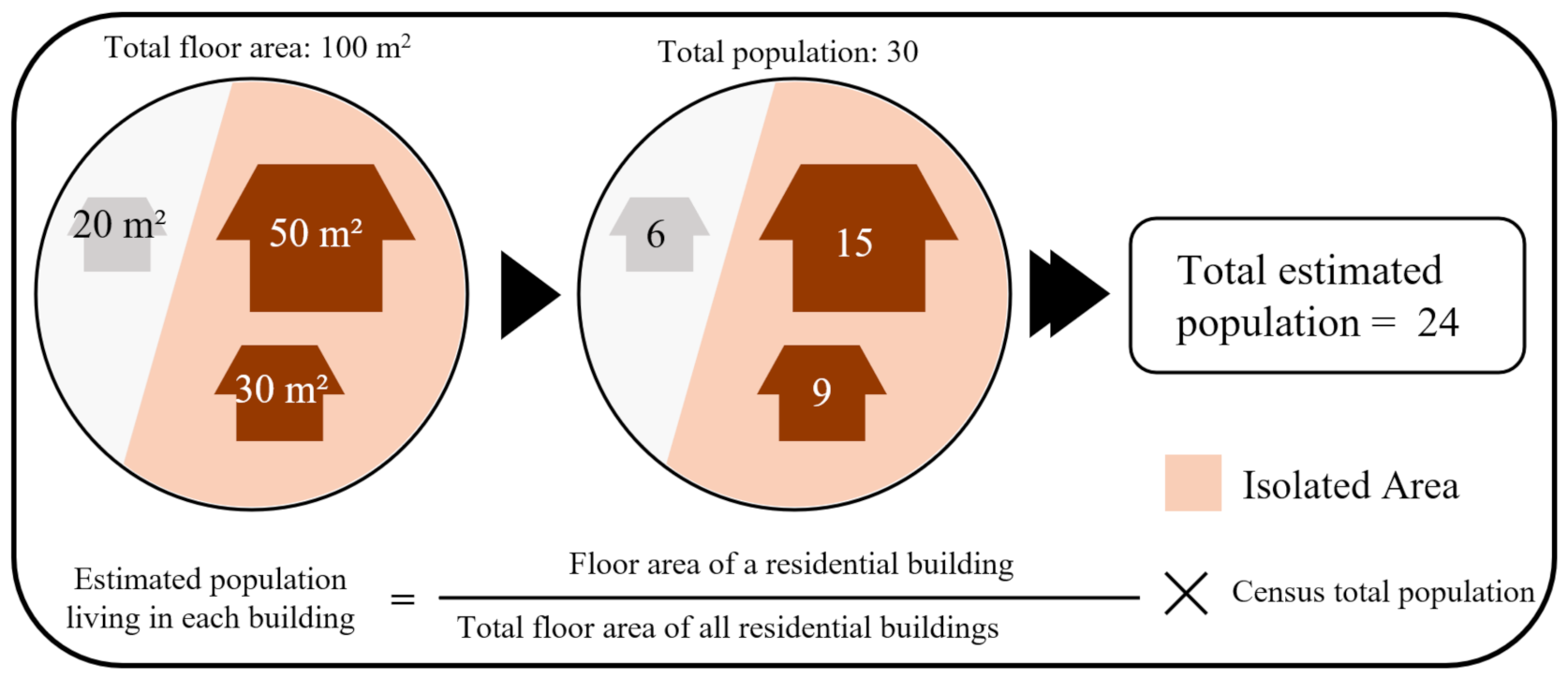

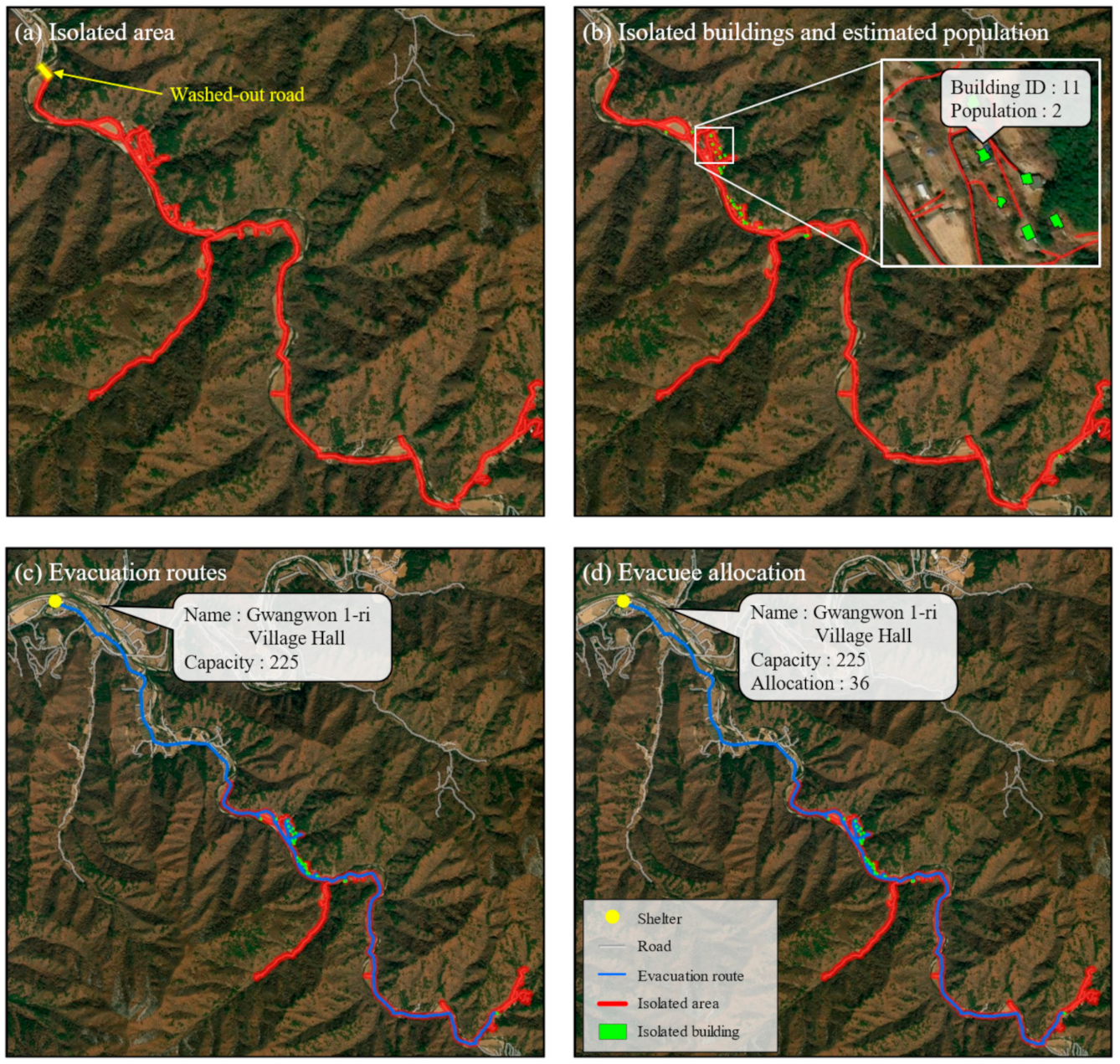
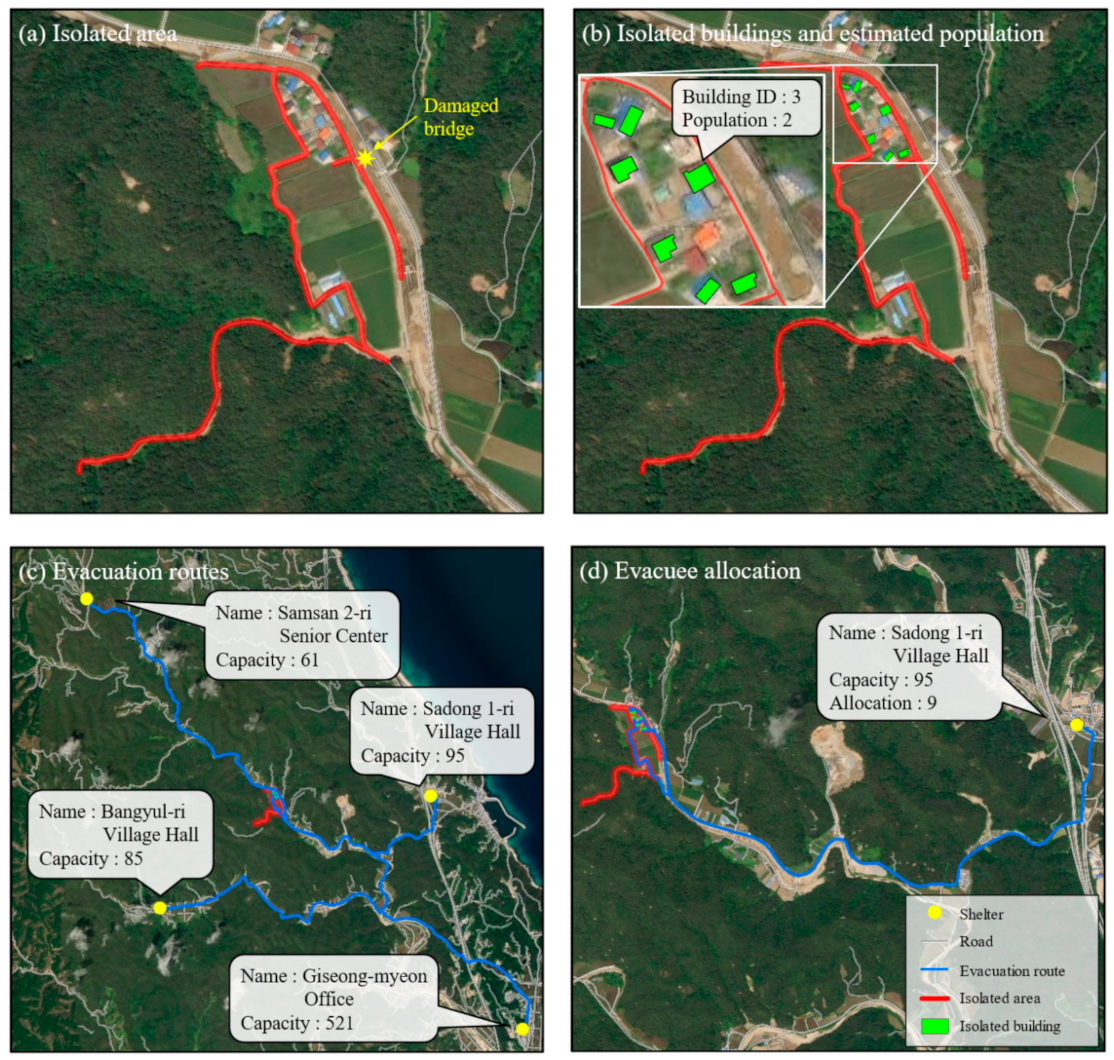


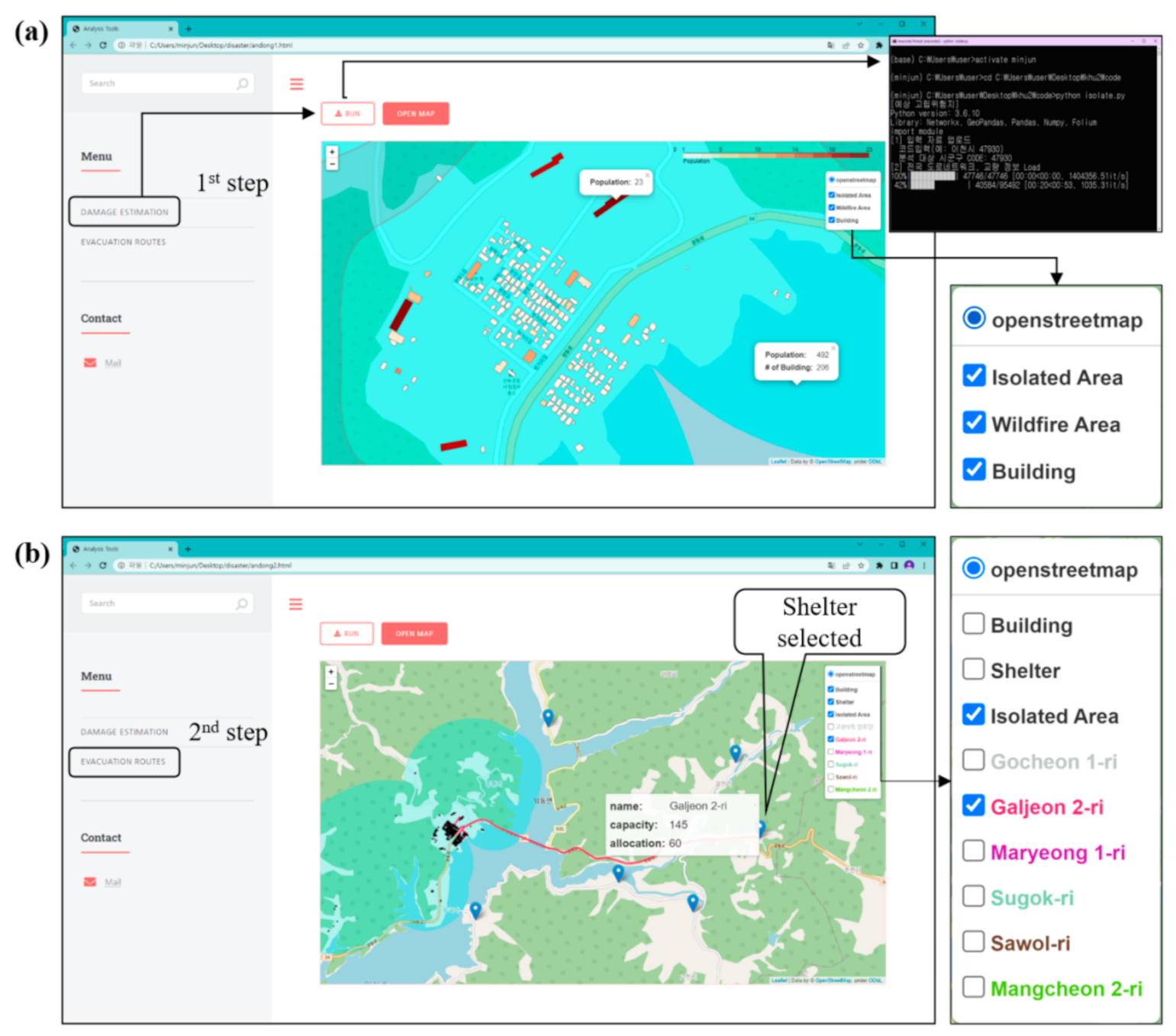
| Name | Feature Types | Source |
|---|---|---|
| Road | Polyline | National Geographic Information Institute |
| Bridge | ||
| Building | Polygon | Ministry of Land, Infrastructure, and Transport |
| Shelter | Point | Ministry of the Interior and Safety |
| Population | Text | Statistics Korea |
| #package networkx, pandas, geopandas, json, numpy #Input data Input: building ← Buildings, shelter ← Shelters, network ← Road networks #Output data Output: routes ← Evacuation route each building shelter_pop ← The number of people assigned to each shelter. #Calculate network geometry FOR EACH edge IN network DO edge.length = distance(edge[a], edge[b]) ← Distance between road nodes END FOR #Shortest route extraction and allocation FOR EACH building IN buildings DO FOR EACH shelter IN shelters DO route ← Dijkstra algorithm route append route to routes append pop to shelter_pop END FOR END FOR |
| #Convert GeoJSON and load GDF.to_file(‘FileName.json’, driver = ‘GeoJSON’) GeoJSON = json.load(open(‘FileName.json’)) #Basemap settings Center = list(reversed(list(GDF[‘geometry’].centroid [0].coords [0]))) baseMap = folium.Map(location = center, tiles = None, overlay = False, zoom_start = n) #Create a layer group and add layer group = folium.FeatureGroup(name = ‘uljin’, overlay = False).add_to(baseMap) building = plugins.FeatureGroupSubGroup(group, name = ‘building Layer’, show =False).add_to(baseMap) population = plugins.FeatureGroupSubGroup(group, name = ‘evacuation Layer’, show = False).add_to(baseMap) #Set and apply object style style1 = {‘color’:’black’, ‘fillColor’:’#B22222, ‘weight’:0.5, ‘fillOpacity’:1.0} style2 = {‘color’:’red’, ‘weight’:1, ‘opacity’:0.5} area = folium.GeoJson(building, style_function = style1, show = False).add_to(baseMap) #Create a marker marker = folium.Marker(location = [lat, lon], popup = ‘marker’, icon = g.Icon(color = “red”)).add_to(baseMap) #Pop-up window settings popup = (‘<div style = “font-size: 15pt” > ‘ + “population:{pop}” + ’</div > ‘).format(pop = feature[‘properties’][‘POP’]) |
| Possible Routes | Distance (km) | Estimated Travel Time (Minutes) | ||||
|---|---|---|---|---|---|---|
| Max. | Min. | Ave. | Max. | Min. | Ave. | |
| 29 | 7.63 | 3.39 | 4.18 | 7.63 | 3.39 | 4.18 |
| Possible Routes | Distance (km) | Estimated Travel Time (Minutes) | ||||
|---|---|---|---|---|---|---|
| Max. | Min. | Ave. | Max. | Min. | Ave. | |
| 7 | 3.74 | 3.59 | 3.69 | 3.74 | 3.59 | 3.69 |
| Shelter ID | Shelter Name | Capacity | Allotted Evacuees | Allotted Buildings |
|---|---|---|---|---|
| 1 | Gocheon 1-ri Senior Center | 163 | 163 | 80 |
| 2 | Gocheon 1-ri Village Hall | 133 | 0 | 0 |
| 3 | Galjeon 2-ri Village Hall | 145 | 60 | 19 |
| 4 | Galjeon 1-ri Village Hall | 126 | 0 | 0 |
| 5 | Maryeong 1-ri Village Hall | 161 | 161 | 81 |
| 6 | Sugok-ri Village Hall | 98 | 98 | 20 |
| 7 | Sawol-ri Village Hall | 106 | 2 | 2 |
| 8 | Mangcheon 2-ri Village Hall | 114 | 8 | 7 |
| 9 | Imha 1-ri Office | 119 | 0 | 0 |
| 10 | Chuwol Village Hall | 81 | 0 | 0 |
| # | Total | 492 | 209 |
| Possible Routes | Distance (km) | Estimated Travel Time (Minutes) | ||||
|---|---|---|---|---|---|---|
| Max. | Min. | Ave. | Max. | Min. | Ave. | |
| 209 | 6.39 | 1.34 | 5.03 | 6.39 | 1.34 | 5.03 |
Publisher’s Note: MDPI stays neutral with regard to jurisdictional claims in published maps and institutional affiliations. |
© 2022 by the authors. Licensee MDPI, Basel, Switzerland. This article is an open access article distributed under the terms and conditions of the Creative Commons Attribution (CC BY) license (https://creativecommons.org/licenses/by/4.0/).
Share and Cite
Yang, B.; Kim, M.; Lee, C.; Hwang, S.; Choi, J. Developing an Automated Analytical Process for Disaster Response and Recovery in Communities Prone to Isolation. Int. J. Environ. Res. Public Health 2022, 19, 13995. https://doi.org/10.3390/ijerph192113995
Yang B, Kim M, Lee C, Hwang S, Choi J. Developing an Automated Analytical Process for Disaster Response and Recovery in Communities Prone to Isolation. International Journal of Environmental Research and Public Health. 2022; 19(21):13995. https://doi.org/10.3390/ijerph192113995
Chicago/Turabian StyleYang, Byungyun, Minjun Kim, Changkyu Lee, Suyeon Hwang, and Jinmu Choi. 2022. "Developing an Automated Analytical Process for Disaster Response and Recovery in Communities Prone to Isolation" International Journal of Environmental Research and Public Health 19, no. 21: 13995. https://doi.org/10.3390/ijerph192113995
APA StyleYang, B., Kim, M., Lee, C., Hwang, S., & Choi, J. (2022). Developing an Automated Analytical Process for Disaster Response and Recovery in Communities Prone to Isolation. International Journal of Environmental Research and Public Health, 19(21), 13995. https://doi.org/10.3390/ijerph192113995







